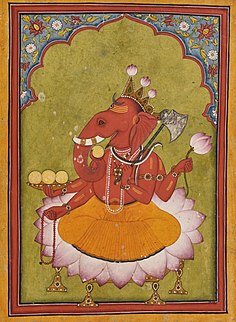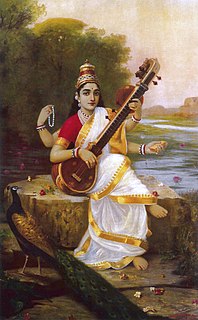
Performing arts are a form of art in which artists use their voices, bodies or inanimate objects to convey artistic expression. It is different from visual arts, which is when artists use paint, canvas or various materials to create physical or static art objects. Performing arts include a range of disciplines which are performed in front of a live audience.

Puppetry is a form of theatre or performance that involves the manipulation of puppets – inanimate objects, often resembling some type of human or animal figure, that are animated or manipulated by a human called a puppeteer. Such a performance is also known as a puppet play. The puppeteer uses movements of her hands, arms, or control devices such as rods or strings to move the body, head, limbs, and in some cases the mouth and eyes of the puppet. The puppeteer often speaks in the voice of the character of the puppet, and then synchronizes the movements of the puppet's mouth with this spoken part. The actions, gestures and spoken parts acted out by the puppets are typically used in storytelling.
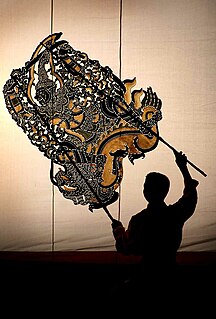
Nang yai is a form of shadow play found in Thailand and Cambodia. Puppets are made of painted buffalo hide, while the story is narrated by songs, chants and music.

Wayang also known as Wajang, is a form of puppet theatre art found in Indonesia and other parts of Southeast Asia, wherein a dramatic story is told through shadows thrown by puppets and sometimes combined with human characters. The art form celebrates the Indonesian culture and artistic talent; its origins are traced to the spread of Hinduism in the medieval era and the arrival of leather-based puppet arts called Tholu bommalata from southern India.

Shadow play, also known as shadow puppetry, is an ancient form of storytelling and entertainment which uses flat articulated cut-out figures which are held between a source of light and a translucent screen or scrim. The cut-out shapes of the puppets sometimes include translucent color or other types of detailing. Various effects can be achieved by moving both the puppets and the light source. A talented puppeteer can make the figures appear to walk, dance, fight, nod and laugh.

The Haridasa devotional movement originated in Karnataka, India, after Madhvacharya, and spread to eastern states such as Bengal and Assam of medieval India. Over a span of nearly six centuries, several saints and mystics helped shape the culture, philosophy and art of South India in general and Karnataka in particular by exerting considerable spiritual influence over the masses and kingdoms that ruled South India.
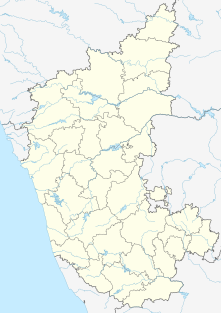
Chitapur or Chittapur is a City and Taluk in Gulbarga District in the state of Karnataka, India. It is also the headquarters of the Chittapur taluk. It is famous for polished stones and toor dal.

Tholu Bommalata is the shadow puppet theatre tradition of the state of Andhra Pradesh in India. Its performers the part of a group of wandering entertainers and peddlers who pass through villages during the course of a year and offer to sing ballads, tell fortunes, sell amulets, perform acrobatics, charm snakes, weave fishnets, tattoo local people and mend pots. This ancient custom, which for centuries before radio, movies, and television provided knowledge of Hindu epics and local folk tales, not to mention news, spread to the most remote corners of the subcontinent. Tholu Bommalata literally means "the dance of leather puppets".

Karnataka has a variety of traditional arts, including folk dance and puppetry.
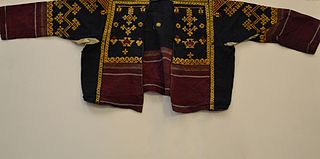
Kasuti is a traditional form of folk embroidery practised in the state of Karnataka, India. Kasuti work which is very intricate sometimes involves putting up to 5,000 stitches by hand and is traditionally made on dresswear like Ilkal sarees, Ravike and Angi or Kurta. The Karnataka Handicrafts Development Corporation (KHDC) holds a Geographical Indications (GI) protection for Kasuti embroidery which provides Intellectual Property rights on Kasuti to KHDC.

Gaarudi Gombe is a folk dance prevalent in the state of Karnataka, India. Dancers adorn themselves with giant doll-suits made of bamboo sticks. The term Gaarudi-Gombe means magical-doll in the native language, Kannada. This dance is performed during major festivals and also in the procession held during the festivities of Mysore Dasara. This dance is also known as Tattiraya in the coastal districts of Karnataka. The term Tattiraya means a person carrying a doll made of bamboo sticks.
Karnataka has been a leading state in electronic communications, in India, since the start of first private radio station in Mysore, in 1935.

The Tripurantaka Temple was built around c. 1070 CE by the Western Chalukyas. This temple, which is in a dilapidated state, is in the historically important town of Balligavi, modern Shivamogga district, Karnataka state, India. The exterior walls of the temple have erotic sculptures on friezes. These depictions are considered rare in Chalukyan art. Being miniature in size, these are visible only upon close examination. During medieval times, Balligavi was a seat of learning to multiple religious faiths and was home to many monuments and structures built by the Chalukyas. More than 80 medieval inscriptions have been discovered in Balligavi and belong to the Shaiva, Vaishnava, Jain and Buddhist faiths. These inscriptions describe, among other things, the building of temples.

A puppet is an object, often resembling a human, animal or mythical figure, that is animated or manipulated by a person called a puppeteer. The puppeteer uses movements of their hands, arms, or control devices such as rods or strings to move the body, head, limbs, and in some cases the mouth and eyes of the puppet. The puppeteer often speaks in the voice of the character of the puppet, and then synchronizes the movements of the puppet's mouth with this spoken part. The actions, gestures and spoken parts acted out by the puppeteer with the puppet are typically used in storytelling. Puppetry is a very ancient form of theatre which dates back to the 5th century BC in Ancient Greece. There are many different varieties of puppets, and they are made from a wide range of materials, depending on their form and intended use. They range from very simple in construction and operation to very complex.

Tholpavakoothu is a form of shadow puppetry that is practiced in Kerala, India. It is performed using leather puppets as a ritual dedicated to Bhadrakali and is performed in Devi temples in specially built theatres called koothumadams. This art form is especially popular in the Palakkad, Thrissur and Malappuram districts of Kerala.
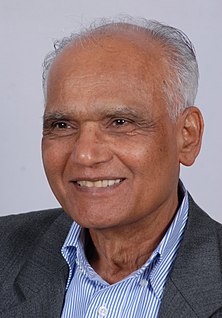
Santeshivara Lingannaiah Bhyrappa is a Kannada novelist whose works are popular in the state of Karnataka, India. Bhyrappa is widely regarded as one of modern India's foremost novelists. His novels are unique in terms of theme, structure, and characterization. He has been among the top selling authors of Kannada language. Books written by him and translated to Hindi and Marathi have also been top sellers in the past. He has been awarded with the 20th Saraswati Samman for 2010.

Aihole in Karnataka state, India, is known as Cradle of Indian architecture. It was the first capital of Chalukyas where they built numerous temples dating back to the 6th century CE.
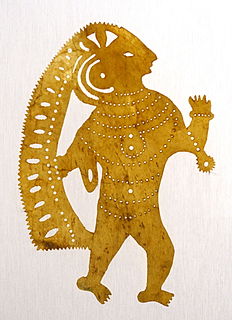
Rabana Chhaya is a form of shadow puppetry from the eastern Indian state of Odisha.
Anurupa Roy is a puppeteer, puppet designer and director of the puppet theater.,, Puppeteer
Anurupa Roy's views puppetry as not "manipulating dolls with strings" but an amalgam of plastic and performing arts where sculptures, masks, figures, materials, found objects and narratives come together with music, movement, physicality and theater to create the theater where humans and puppets are co actors. She started at her group Katkatha in 1998 which was registered as the Katkatha Puppet Arts Trust 2006. She has directed over 15 shows for children and adults ranging from the Ramayana and Mahabharata to Shakespearen comedy to the Humayun-nama. The puppets used by the group range from 3 inches to forty feet. The shows have toured across Europe, Japan and South Asia., A major aspect of her work is using puppets for psycho social interventions in conflict areas like Kashmir, Sri Lanka and Manipur to Juvenile Remand homes. She has worked with youth and women across the country using puppets to raise awareness about HIV/AIDS and gender issues. She is a recipient of the Ustad Bismillah Khan Yuva Puraskar ine Puppetry(2006). She has been a visiting faculty at the University of California Los Angeles an Artists in Residence at Pro Helvetia Swiss Arts Council.

Wayang kulit is a traditional performing arts of puppet-shadow play found in the cultures of Java, Bali, and Lombok, in Indonesia. In a wayang kulit performance, the puppet figures are rear-projected on a taut linen screen with a coconut-oil light. The Dalang manipulates carved leather figures between the lamp and the screen to bring the shadows to life.







